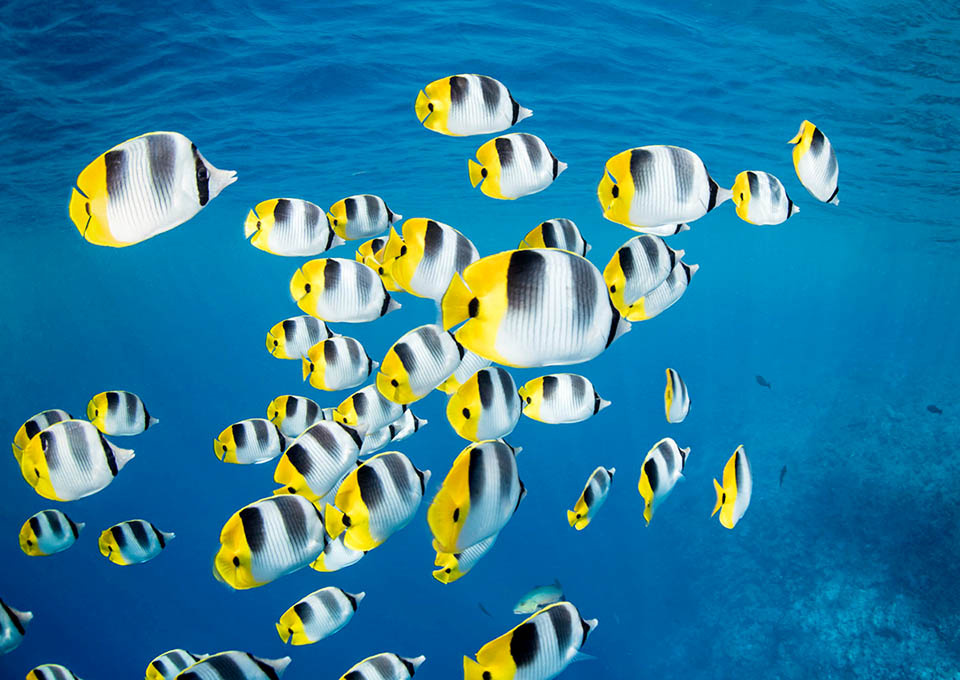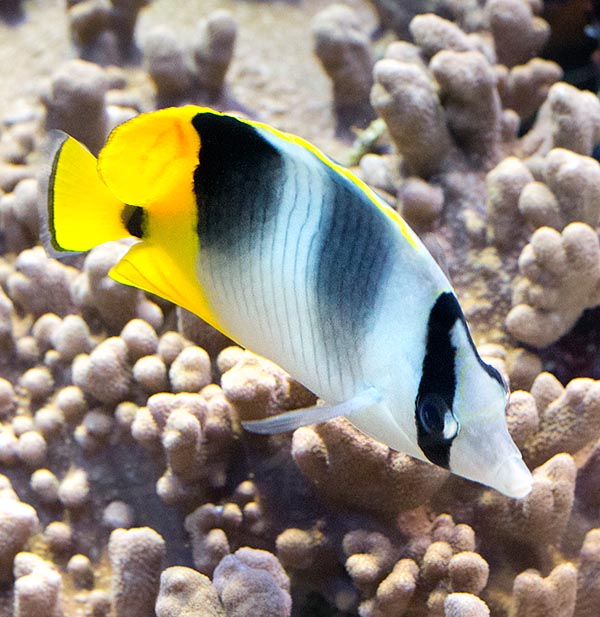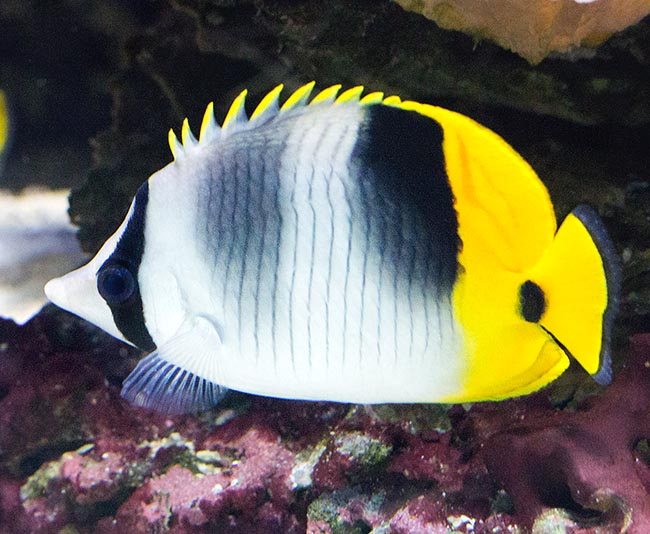Family : Chaetodontidae

Text © Giuseppe Mazza

English translation by Mario Beltramini

The Pacific double-saddle butterflyfish (Chaetodon ulietensis) has a very vast distribution in the Pacific Ocean and neighboring areas of the Indian Ocean © Richard Barnden
The unusual and mimetic Pacific double-saddle butterflyfish (Chaetodon ulietensis Cuvier, 1831) belongs to the class of the Actinopterygii, the ray-finned fishes, to the order of Perciformes and to the family of Chaetodontidae.
The name of the genus Chaetodon comes from the Greek “χαίτη” (khaite) = hair and “ὀδούς” (odous) = tooth, due to the “bristle-shaped teeth”.
The name of the species ulietensis = of Uliétéa in Latin, refers to the island of Uliétéa, today known also as Raiatea Island, belonging to the Society Islands, Leeward Islands, in French Polynesia.

Flat like all butterflyfishes, Chaetodon ulietensis is practically omnivorous © Giuseppe Mazza
Zoogeography
It is a species at home in the Pacific Ocean and in the neighbouring zones of the Indian Ocean.
We find it at the Maldives, the Cocos Islands, Christmas Island, Malaysia, Australia, Indonesia, New Guinea, Micronesia, New Caledonia, Philippines, Taiwan and China up to south of Japan. Eastwards, it reaches the Fiji Islands, Tonga, Samoa, Tahiti, Tuamotu and the Hawaii; southwards, Lord Howe and Easter Islands.
Ecology-Habitat
It lives in the madrepores formations up to 30 m of depth, usually in the calm lagoon side and not on the side facing the sea. The juveniles are frequent also in the brackish waters of the estuaries and the harbours.
Morpho-physiology
The Pacific double-saddle butterflyfish is a species similar to the Chaetodon falcula with which is often mistaken. Slightly smaller, it does not exceed the 15 cm, against the other’s 20 cm, and like this one it has a livery with vertical stripes on pale background, a black spot on the caudal peduncle, the black band on the eye and, especially, two dark saddles on the back.
But here the dorsal spots do not have the shape of a sickle and are much more shaded. The first, towards the head, appears decidedly faded, and the second, black upwards, turns to the grey towards the belly.
In both fishes the final part of the body, fins included, is yellow with analogous orange traits, but in the Chaetodon falcula, starting from the first saddle; the back is yellow, whilst in the Chaetodon ulietensis the yellow is present only at the border of the dorsal fin. This shows 12 spiny rays and 23-25 soft, the anal 3-4 spiny rays and 19-21 soft, whilst the ventral and the pectoral ones are unarmed and the caudal is more or less truncate.

Due to this and the modest size it’s required by the aquaria trade © Giuseppe Mazza
The body is flat like all butterflyfishes, more or less oval with elongated snout.
Due to the vertical striped drawing and the colour, it recalls also the Chaetodon lineolatus which, with its 30 cm of length, is the biggest member of the genus Chaetodon.
Ethology-Reproductive Biology
The Pacific double-saddle butterflyfish can live solitary or in small schools.
During the reproductive period, more or less stable pairs take form and after the fecundation the eggs are entrusted to the currents.
It nourishes of various benthic invertebrates and of seaweeds.
The populations can double in less than 15 months, and seen that it is omnivorous, in spite of the climate changes and the vast aquaria market, the vulnerability index of the species is very low
In fact, it appears in the Red List of endangered species as “Least concern“.
Synonyms
Chaetodon aurora De Vis, 1885; Chaetodon ulietensis confluens Ahl, 1923.
→ For general information about FISH please click here.
→ For general information about BONY FISH please click here
→ For general information about CARTILAGINOUS FISH please click here.
→ To appreciate the BIODIVERSITY of BONY FISH please click here.
→ To appreciate the BIODIVERSITY of CARTILAGINOUS FISH please click here.
